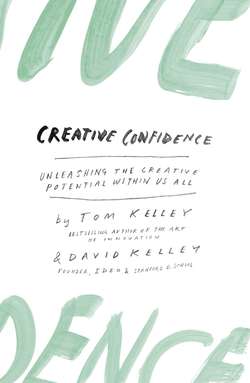Читать книгу Creative Confidence: Unleashing the Creative Potential Within Us All - David Kelley - Страница 24
PERMISSION TO FAIL
ОглавлениеWhether you consider yourself a “born innovator” or are new to creative confidence, you can get better faster at coming up with new ideas if you give yourself and those around you the leeway to make mistakes from time to time. Permission to fail comes more easily in some settings than others. Venture capitalist Randy Komisar says that what distinguishes pockets of entrepreneurship like Silicon Valley is not their successes but the way they deal with failure. In cultures that encourage entrepreneurs, there is a greater appreciation and understanding of what Komisar calls “constructive failure.”
Fear of risk and failure was a central theme when IDEO worked with German entrepreneur Lars Hinrichs on reinventing European venture capital. Research with software developers in the United States and Europe showed that the transition from a stable corporate job to the uncertainty of an early startup was one of the scariest moments in the evolution of a new venture. Many never managed to take that leap of faith. For lots of fledgling entrepreneurs, leaving the comfort and security of a salaried job stopped them in their tracks. So we structured the offering for Hinrichs’s new early-stage investment company, HackFWD, to make that transition less intimidating. We helped give entrepreneurs a support network and resources so they could focus their efforts on what they do best. As part of HackFWD’s “Geek Agreement”—published on the firm’s website—entrepreneurs are paid roughly their current salary for a year as they push their concept toward the beta stage and one step closer to market and profitability. They also get connected to a network of experienced advisors. Quitting your day job remains a scary step, but maintaining your current income for a year makes it easier to pursue new-to-the-world ideas.
Within large companies, CEOs and executives have started to make similar efforts to reduce perceived risks and show their commitment to innovation initiatives. For example, VF Corporation—the world’s largest apparel company and owner of dozens of familiar brands ranging from Nautica to The North Face—started an internal innovation fund a few years ago. Overseen by vice president of strategy and innovation Stephen Dull, the fund helps bootstrap innovative ideas at their earliest stages. It allows business unit managers to take entrepreneurial risks while meeting all the performance targets with their current product offerings. One successful innovation fund program explored whether VF’s Wrangler brand, historically popular with cowboys in the American West, could be translated to appeal to motorcycle riders in India. The result was a line of jeans with features like water-repellent fabric that appeal to India’s highly mobile youth market. To date, VF’s innovation fund has sponsored more than ninety-seven such innovative ventures around the world.
We all need the latitude to try out new ideas. Look for ways to grant yourself creative license, or give yourself the equivalent of a get-out-of-jail-free card. Label your next new idea an experiment, and let everyone know that you are just testing it out. Lower others’ expectations, so that failure can lead to learning without career damage.
